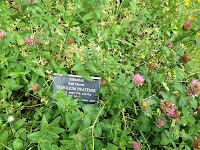Your name
Your street
address
Your suburb
& postcode
Today’s
date
Advertising Consultation
Recalls and Advertising Section
Office of Product Review
Therapeutic Goods Administration
PO Box 100
WODEN ACT 2606
Re: Advertising Consultation
As a member of the public who is/has been a patient of the
naturopath, Claudette Wadsworth, for x years and has received significant
health benefit from her practice, I want to express my concern about the
proposed regulation of advertising of therapeutic goods to consumers and the
effects of the proposed changes on the professions of Western herbalists and
naturopaths.
Western herbalists and naturopaths currently hold TGA
exemption from Part 5-1 of the Therapeutic Goods Act; this allows them to
receive technical information from companies regarding herbs and supplements
regarded as tools of trade for these professions. It has been noted that proposal 6.2 will have a detrimental
impact on the practise of Western herbal medicine and naturopathy, and proposal 5 will also have a deleterious
impact should proposal 6.2 be
implemented.
My concerns relate to the following proposal:
Option 1: Status quo - maintain the current system.
Option 2: Update the exemption for health professionals in
section 42AA of the Act to only recognise health practitioners regulated under
the Health Practitioner Regulation National Law.
Either the current list of health professionals should
remain (option 1) or Western
herbalists and naturopaths be added to the new list. As previously mentioned,
option 2 deprives herbalists and naturopaths tools of trade to practise
effectively and safely.
The potential consequences of not considering these
suggestions will have an impact on the following:
Public safety: Currently practitioners receive important technical
information on efficacy and safety of listed therapeutic goods from companies
both in written material and via face-to-face seminar activities that comprise
a portion of continuing education for the professions. Such activities
encourage not only the updating of knowledge vital for safe professional
practice but also employ critical analysis of research, sharing of professional
knowledge, and promote other professional behaviours such as adverse reaction
reporting. All these elements contribute to public safety.
Maintaining expertise: Herbalists and naturopaths currently hold
expertise in herbal and nutritional medicine, in particular holding the highest
qualification resulting in the prescription of herbal medicines. A recent study
confirmed herbalists and naturopaths had similar knowledge to pharmacists in
clinically proven benefits of herbal medicines, and significantly better
knowledge than pharmacists of clinically significant interactions
. These
findings provide evidence that contradicts the TGAs argument for excluding
naturopaths and herbalists as recognised health professionals.
Scope of Practice: The current minimum standard to practice Western
herbal medicine and naturopathy is an advanced diploma. However, the
professions are moving toward Bachelor degree as minimum standard, and many
hold post-graduate qualifications. The professions are also moving from a
mainly tradition based body of knowledge to evidence based practice (EBP)1.
This is supported by current education standards in all tertiary education
sectors and NHAA course accreditation requirements for research, clinical
sciences, herbal therapeutics and toxicology.
ARONAH: In 2011 an independent register The Australian
Register of Naturopaths and Herbalists (ARONAH), was formed to mirror
the government statutory regulated boards of AHPRA. ARONAH began taking
applications for registration on 1 July 2013. The main stated purpose of ARONAH
is the provision of minimum education standards for herbalists and naturopaths
in Australia, and it will also provide an easily transferable model of
statutory registration should herbalists and naturopaths achieve registration
with AHPRA. ARONAH may provide a good interim solution with regards to
identifying appropriately trained herbalists and naturopaths once it is better
established.
In conclusion I recommend that the TGA either maintaining
the status quo (6.1) or add herbalists and naturopaths to the new exemption
list as they are legitimate qualified health practitioners. To do otherwise is
to add risk to public safety and adversely affect the practice of herbal
medicine and naturopathy, potentially resulting in professional and financial
hardship.
Yours sincerely
Your name and qualifications
Braun, LA, Spitzer, O,
Tiralongo, E, Wilkinson, JM, Bailey, M, Poole, SG, & Dooley, M. (2012).
Naturopaths and Western herbalists’ attitudes to evidence, regulation,
information sources and knowledge about popular complementary medicines. Complementary therapies in medicine. 2012;21:58-64.













